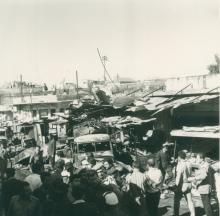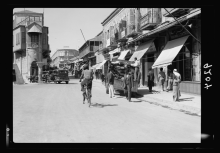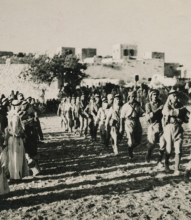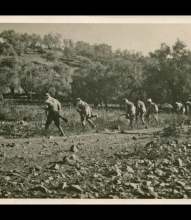15 نيسان 1936. على الطّريق بين نابلس وطولكرم. فرحان السّعدي وعدد من رفاقه يتربّصون لسيّارة صهيونيّة وبنادقهم في أيديهم. تُطلق النار؛ يُقتل أحد الصّهاينة، وتكون تلك الرّصاصةَ الأولى لثورة عام 1936، ونواةَ حرب عصابات سيدفع فيها الصّهاينة والبريطانيّون أثمانًا باهظة، ومقدمةً لبدء الإضراب الشامل في فلسطين، وإعلانِ الحكومة البريطانية حالة الطّوارئ في البلاد.
هذه الثّورة، التي بدأت بأدوات بدائيّة وهجمات عشوائيّة ومظاهرات أشعلت المدن والقرى، حدت بالقيادة الفلسطينيّة إلى اتّخاذ موقف سريع انتهى بتشكيل اللّجنة العربيّة العليا من جميع القوى والأحزاب الفلسطينيّة، وانتخاب الحاج أمين الحسيني رئيسًا لها، لتحدّد اللّجنة مطالبها بمنع الهجرة اليهوديّة منعًا باتًّا، ومنع انتقال الأراضي إلى اليهود، وأخيرًا إنشاء حكومة وطنيّة مسؤولة أمام مجلس نيابيّ.
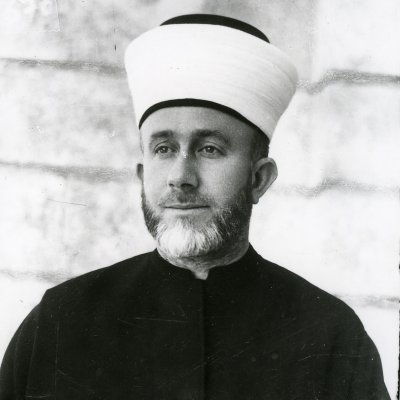
Muhammad Amin al-Husseini was born in Jerusalem. His father, Haj Tahir al-Husseini, married twice: Zainab, with whom he had two sons, Muhammad and Kamel, and Mahbuba, with whom he had eight sons. Muhammad Amin had one son, Salah al-Din, and six daughters: Zainab, Suad, Asma, Nafisa, Jihad, and Amina.
He was educated in Jerusalem and then at al-Azhar Mosque in Cairo. He performed the pilgrimage with his family in 1913, while he was still a young man, and he was called “Haj” until the end of his life.
His father sent him to Istanbul in 1915 to continue his education, but he joined the Military Academy, graduating as a non-commissioned officer. He then joined the Arab Revolt led by Prince Faisal before the end of World War I.
He was appointed in 1918 as special adjutant to the British Military Governor but soon resigned in protest over the pro-Zionist policy of Britain and taught at al-Ma‘arif college in Jerusalem.
He was elected president of the Arab Club in Jerusalem, the first political group in Palestine to publicly reject the Balfour Declaration. In 1920, the British authorities sentenced him to prison in absentia for having led demonstrations that year. He escaped to Karak and from there to Damascus during the Faisal government.
He returned to Jerusalem later that year after having been pardoned by the newly appointed High Commissioner, Sir Herbert Samuel. When his elder brother Kamel died, he succeeded him as Mufti in May 1921. In January 1922 he was appointed president of the Supreme Moslem Council, instituted by the High Commissioner, so Haj Amin came to occupy these two important posts until he was driven out of Palestine in 1937. He displayed great energy and determination in these posts; he led the nationalist movement in secret, being wary of the British authorities. He thus became the most prominent and influential Arab leader in the country. The supporters of Haj Amin were known as al-majlisiyyun (council proponents) in reference to the Supreme Moslem Council (al-Majlis). The opposition to the council was led by Raghib al-Nashashibi.
The Zionists accused him of having incited the al-Buraq/ Western Wall Disturbances of 1929, but the British authorities cleared him of that charge. In 1931, he supervised the convening of the Pan-Islamic Congress in Jerusalem, hoping to mobilize the Muslim world to oppose Zionism, which itself had mobilized its world potential. He chaired the meetings of that congress. That congress firmly established his reputation in the Arab and Islamic spheres. In 1933 he toured a number of Arab countries including Iraq, Kuwait, and Saudi Arabia, urging support for the cause of Palestine, and acted as a mediator to end the fighting between Saudi Arabia and Yemen in 1933.
In 1936, and after some hesitation, he presided over the Arab Higher Committee, which included the leaders of all Palestinian parties and which led the general strike of 1936 and the Great Palestinian Rebellion of 1937–39 to protest the partition plan advocated by the Royal Commission chaired by Lord Peel.
After Arab rebels assassinated Lewis Andrews, British district commissioner for Galilee, in September 1937 soon after publication of the Peel Report, the British Government dismissed Haj Amin from his post as president of the Supreme Moslem Council and decided to arrest all members of the Arab Higher Committee including Haj Amin. He took refuge in the Noble Sanctuary (al-Haram al-Sharif) and then fled to Jaffa and Lebanon from where he continued to lead the revolt until the outbreak of World War II. He escaped from Lebanon and took refuge in Iraq to evade arrest by the French Mandate authorities.
The British government declined to invite Haj Amin to the London Conference of 1939 from which was issued the White Paper of 1939, which Haj Amin rejected. The government did however send an envoy to negotiate with people close to him about the White Paper but British prime minister Winston Churchill, an overzealous supporter of the Zionists, soon aborted these negotiations.
In Iraq, Haj Amin became the focal point of the Iraqi national anti-British movement, which eventually led to the revolt of Rashid Ali al-Kailani.
When the Kailani revolt collapsed in 1941, Haj Amin left Iraq for Iran, and then to Turkey (which refused to grant him asylum) and the Axis Powers, Germany and Italy. Haj Amin spent the war moving between Berlin and Rome and took part in the propaganda war against Britain and France through Arabic radio broadcasts from Axis radio stations.
After the defeat of the Axis powers, Haj Amin attempted without success to seek refuge in Switzerland but was captured by French troops in Germany; he managed to escape. The French authorities turned a blind eye to his “escape” in order to spite London for its role in making France leave Syria and Lebanon after World War II. So, in April 1946, Haj Amin took refuge in Egypt and was a guest of King Faruq. He made Cairo his headquarters because the British authorities would not allow him to return to Palestine.
The Arab League had in 1946 reconstituted the Arab Higher Committee, leaving the post of president vacant. While in Egypt, Haj Amin assumed its presidency and reorganized it. This organization then led the Palestinian national movement during the last years of the British Mandate and opposed the UN Partition Resolution of 1947. During the years 1946–48, Haj Amin led the Palestinian national movement, moving between Cairo, Beirut, and Damascus but not Baghdad or Amman.
When the British Mandate ended, Haj Amin opposed the entry of Arab regular and irregular forces to Palestine to try to prevent partition and the rise of a Jewish state in 1947–48. He asked instead that the Arabs of Palestine be supplied with money and weapons, formed a force called the Holy Jihad made up from local fighters under his leadership, and then organized National Committees in the cities to act for the Arab Higher Committee and called for the formation of a Palestinian Arab Government as soon as the Mandate came to an end. He was also determined to return to Palestine to take charge of all these activities, but the opposition of the governments of Iraq, Transjordan, and Britain prevented the Arab League from agreeing to his plans.
In September 1948, the Arab Higher Committee in Gaza proclaimed the formation of the All-Palestine Government, headed by Ahmad Hilmi Abd al-Baqi, with the support of Egypt and the non-Hashemite Arab countries. Haj Amin presided over the Palestine National Council, held in Gaza, which confirmed the legality of that government. However, because of the collapse of the Egyptian front in October and in November 1948, Haj Amin and the government moved to Egypt and remained there.
After the Nakba and the signing of the armistice agreements between the Arab states and Israel, followed by the annexation of the West Bank by the Hashemite kingdom of Jordan and the placement of the Gaza Strip under Egyptian administration, the role of Haj Amin and the Arab Higher Committee began to diminish and lose influence. Haj Amin remained in Egypt until 1959 and then moved to Lebanon where he settled and spent the remainder of his life. He advocated the liberation of Palestine by force of arms and oversaw the affairs of Palestinian refugees through the two bureaus of the Arab Higher Committee in Damascus and Beirut. He also travelled among the capitals of the Islamic world to garner support for the cause to which his life was dedicated.
Haj Amin al-Husseini was a man of firm and unwavering convictions who never retreated from positions he considered right and just. He played the most important role in Palestinian politics during the Mandate and was keenly attentive to the Arab and Islamic worlds. He sought tirelessly to make the Palestine cause a common concern for these worlds but was unable to bring the Palestinian opposition over to his side. There were many reasons why he failed to organize the Palestinians into a force capable of resisting the Zionist movement, especially during the decisive period when that movement determined to occupy Palestine by force of arms following the UN Partition Resolution of 29 November 1947. That resolution was in any case the result of pressures put on the new and unelected US president Harry Truman, who had succeeded Franklin Roosevelt.
Haj Amin died in Beirut in 1974 and was buried in the Martyrs' Cemetery.
Sources
دروزة، محمد عزة. "مذكرات محمد عزة دروزة: سجل حافل بمسيرة الحركة العربية والقضية الفلسطينية خلال قرن من الزمن (خمسة مجلدات). بيروت: دار الغرب الإسلامي، 1993.
العودات، يعقوب. "من أعلام الفكر والأدب في فلسطين". عمان: د. ن.، 1976.
"الموسوعة الفلسطينية"، القسم العام، المجلد الرابع. دمشق: هيئة الموسوعة الفلسطينية، 1984.
نويهض، عجاج. "رجال من فلسطين". بيروت: منشورات فلسطين المحتلة، 1981.
Abdul Hadi, Mahdi, ed. Palestinian Personalities: A Biographic Dictionary. 2nd ed., revised and updated. Jerusalem: Passia Publication, 2006.
صعّد الفلسطينيّون من إضرابهم ليشمل جميع القطاعات، بما في ذلك العاملون في البلديّات، باستثناء عمال الكهرباء والمياه والمسؤولين عن النّظافة العامّة.1
اتّخذت المقاومة الفلسطينيّة المسلّحة في الثّورة كلّ الأشكال المتاحة والممكنة، استخدم الفلسطينيون خلالها القنابل لتفجير مراكز الشّرطة، وحطّموا السّيارات وقطعوا الاتصالات وأشعلوا النّار في المقرّات والمراكز، كما هاجموا المستعمرات والمزارع اليهوديّة، وركّزوا في هجومهم على المواصلات اليهوديّة والبريطانيّة باستخدام كلّ الطّرق، بدءًا من المسامير وحتّى المتفجرات والبنادق.2
كانت النّساء الرّيفيّات يرسلن الطّعام والشّراب إلى الثّوار في الجبال، وينقلن لهم العتاد العسكريّ، بوضع البارودة بين أكوام الخشب وحملها على رؤوسهنّ وصولًا إلى الثّوار.3
كما شاركت المرأة الفلسطينيّة في نقل المعلومات والأخبار وتحرّكات الجيش، فالمرأة في المدينة توصلها للمرأة الرّيفية الّتي تقوم بدورها بإيصالها إلى الثّوار في الجبال، لتشكّل النّساء بذلك ما يوصف بـ "حلقة اتّصال ومخابرات".4
هذه الآليّة في نقل الأخبار كانت فعّالة جدًّا في مساعدة الثّوار على الاختباء، مستخدمة أساليب طريفة وغنائيّة تحوّلت لاحقًا إلى نوع من الفنون الشّعبيّة، مثل ما فعلته جميلة في قرية عناتا عندما قامت بإنذار أحمد العيساوي وعدد من الثّوار المختبئين في قريتها عند مداهمة الإنجليز، وأخذت تغنّي وتقول:
"يا سامعين الصّوت صلوا على محمد، اللّي شاف، اللّي قام، اللّي حط يجعله من قلّة الولاد، من قلّة شو؟ من قلّة الصّغار يلاعب الغار، من قلّة اللّي ينطّ يداعب القطّ، نطّ يا قرد نطّ".5
كانت النّساء في كلّ يوم من أيّام الثّورة يشاركن بطرق لا تنتهي في مقاومة الإنجليز واليهود، وكن يشتبكن، مثلًا، بالأيدي مع قوات الانتداب لتخليص الثّوار، كما قمن بتخريب سير العمليات الإنجليزيّة بإلقاء المسامير تحت عرباتهم، وكن يقذفن مركباتهم بالحجارة.6 كما لعبن دورًا هامًا في الحفاظ على الأسلحة وحمايتها، فكانت المرأة الرّيفيّة تستغلّ المساحات الواسعة والخضرة المحيطة والطّوابين من أجل إخفاء قطع السّلاح، في حين كانت نساء المدينة يُلقين الأسلحة داخل آبار البيوت لإخفائها عن أبصار الإنجليز.7 وبعض النّساء كنّ يخبئن السّلاح في ثوبهنّ الفضفاض، وشاركن بذلك في تنفيذ عدد من عمليّات اغتيال العملاء، ومنهن شمّة الحسن الّتي كانت تبيع اللّبن في حيفا، وكانت تحمل المسدّس في ملابسها وتنقله من مكان لآخر حتى توصله إلى الشّخص المعنيّ، وهي تحمل اللّبن وتبيعه وتصيح "لبن، لبن"، وبعدها يقوم الثائر بقتل الشّخص المطلوب ويعيد المسدس إلى شمة وتهرب من المكان وهي لا تزال تبيع اللّبن.8
حملت المرأة السلاح أيضًا وتدربت عليه وعلى الاشتباك المباشر مع العدو، واشتهرت نساء طيرة حيفا ورامين بذلك. وكان أن قامت نساء رامين بإطلاق النار على الإنجليز عندما اعتقلوا حراس عبد الرحيم الحاج محمد العشرة، ليعرفوا أن هناك مقاتلين من غير المأسورين، وحتى لا يثبت عليهم الجرم.9
وفي 14 أيار 1936، اجتمعت السّيّدات العربيّات في يافا وتبنّين قرارات اللّجنة العربية العليا وشدّدن على استمرار الإضراب حتى نيل الحقوق.10 كما أصدرت لجنة سيّدات القدس بيان المئة بتاريخ 27 تمّوز 1936، حيّين فيه ثبات فلسطين العربية وجهادها، ووجّهن تحيّة للمنفيّين والمبعدين والسّجناء.11 حتّى أنّهن شاركن في النّزول إلى الشّوارع واستخدام العصيّ مع من يخرق الإضراب من البائعين، وكانت من أشهر تلك النّساء مؤمنة سلطان مسودي.12
وفي نقلة استراتيجيّة للثّورة، تحولت الهجمات المتفرّقة والعمليّات المرتجلة إلى معارك نوعية أخذت شكلًا أكثر تنظيمًا وفاعلية. فبعد أشهر قليلة على بداية الثّورة، تمكّن الثّوار من إسقاط طائرة وتدمير ثلاث سيّارات في معركة بلعا، تبعها تدمير ثلاث طائرات إنجليزيّة ووقوع عدد من الخسائر البشريّة في صفوف الإنجليز.
إلّا أنّ الضّربة هذه المرّة جاءت من الدّاخل، عندما أعلنت اللّجنة الوطنيّة العليا فكّ الإضراب. لم يعنِ هذا الإعلان توقّف الثّورة، ولكنّه عنى بقاء الفلسطينيّين دون قيادة وطنية موحدة، مما حدا بالفصائل والثّوّار إلى العمل باستقلاليّة تامّة في تنفيذ هجماتهم وقيادة معاركهم.13
خلال العامين التّاليين، حقق الفدائيّون والمقاومون ضربات موجعة لليهود والسّلطات البريطانيّة، اعتمدوا خلالها على إلقاء القنابل نحو أفراد الشّرطة والمستوطنات وأملاك اليهود والسّلطات البريطانيّة، وعملوا على نسف خطوط الحديد، وقطع خطوط التّلغراف، ونسف الطّرق والمصالح الحكوميّة، والاغتيالات، وتفجير خطوط البترول. وبلغ عدد العمليّات الّتي نفّذها الثّوار خلال العام الأول من الثّورة 4076 عملية، كان من بينها 1996 عمليةً ضدّ أفراد يهود، في حين استهدفت 895 عمليّةً منها ممتلكات اليهود في المدن المختلفة، و795 عمليّةً وُجّهت ضدّ جيش الانتداب وشرطته، و380 ضدّ وسائل المواصلات.
وفي مرحلة ما من الثّورة، استطاع الثّوّار أن يبسطوا سيطرتهم على معظم الطّرق وعدد من المدن الرّئيسة، وسيطروا على معظم المناطق الجبليّة، حتّى تمكّنوا من التّحرك بحرّيّة كاملة في وضح النّهار في نابلس.14
قد تكون الثّورة الكبرى قد أجهضت في مرحلة ما من العام 1939، إذ لعبت التّغيّرات العالميّة دورها في ذلك. فنشوب الحرب العالميّة الثّانية ووجود القيادات الفلسطينيّة خارج البلاد، وسقوط القيادات النّاشئة في ميادين القتال واحدةً تلو أخرى، كلّها كانت كفيلة بإنهاك الثّوار وتداعي الثّورة، الّتي انتهت مع نهاية معركة ترشيحا،15 إلّا أنّ التّاريخ النّضاليّ والشّعبيّ لهذه الثّورة ما زال مرجعًا فلسطينيًّا مُلهمًا للمقاومة.
قائمة مصادر
- 1كبها، مصطفى داوود. ثورة 1936 الكبرى: دوافعها وانعكاساتها. الناصرة: منشورات مكتبة القبس، 1988، ص 55.
- 2خليفة، أحمد. الثورة العربية الكبرى في فلسطين، الرواية الإسرائيلية الرسمية. بيروت: مؤسسة الدراسات الفلسطينية، 1989، ص 18.
- 3عبد الهادي، فيحاء. أدوار المرأة الفلسطينية في الثلاثينات 1930. المساهمة السياسية للمرأة الفلسطينية. البيرة: مركز المرأة الفلسطينية للأبحاث والتوثيق، 2005، ص 33-34.
- 4المصدر السابق، ص 46.
- 5المصدر السابق، ص 47 - 48.
- 6المصدر السابق، ص 49- 52.
- 7المصدر السابق، ص 83- 85.
- 8المصدر السابق، ص 107.
- 9سرحان، نمر و كبها، مصطفى. سجل القادة والثوار والمتطوعين لثورة 1936-1939. القدس: دار الهدى، 2009، ص 298.
- 10خرطبيل، وديعة. ذكريات ومذكرات وديعة قدورة خرطبيل: بحثا عن الأمل والوطن، ستون عاما من كفاح امرأة في سبيل قضية فلسطين. بيروت: بيسان للنشر والتوزيع، 1995، ص 75.
- 11المصدر السابق، ص 76.
- 12سرحان، نمر و كبها، مصطفى. سجل القادة والثوار، ص 723.
- 13كنفاني، غسان. ثورة 36 – 39: خلفيات وتفاصيل وتحليل. القدس: مطبعة الناصر، الوكالة الفلسطينية للصحافة والنشر.
- 14المصدر السابق.
- 15المصدر السابق.
